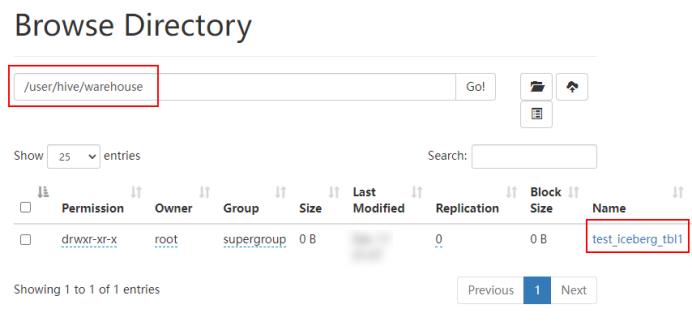数据湖:Hive与Iceberg整合
Posted Lansonli
tags:
篇首语:本文由小常识网(cha138.com)小编为大家整理,主要介绍了数据湖:Hive与Iceberg整合相关的知识,希望对你有一定的参考价值。

文章目录
二、Hive中操作Iceberg格式表
1、如果没有设置iceberg.catalog属性,默认使用HiveCatalog来加载
2、如果设置了iceberg.catalog对应的catalog名字,就用对应类型的catalog加载
3、如果iceberg.catalog属性设置为“location_based_table”,可以从指定的根路径下加载Iceberg表
Hive与Iceberg整合
Iceberg就是一种表格式,支持使用Hive对Iceberg进行读写操作,但是对Hive的版本有要求,如下:
| 操作 | Hive 2.x | Hive 3.1.2 |
| CREATE EXTERNAL TABLE | √ | √ |
| CREATE TABLE | √ | √ |
| DROP TABLE | √ | √ |
| SELECT | √ | √ |
| INSERT INTO | √ | √ |
这里基于Hive3.1.2版本进行Hive操作Iceberg表讲解。
一、开启Hive支持Iceberg
1、下载iceberg-hive-runtime.jar
想要使用Hive支持查询Iceberg表,首先需要下载“iceberg-hive-runtime.jar”,Hive通过该Jar可以加载Hive或者更新Iceberg表元数据信息。下载地址:https://iceberg.apache.org/#releases/:

将以上jar包下载后,上传到Hive服务端和客户端对应的lib目录下。另外在向Hive中Iceberg格式表插入数据时需要到“libfb303-0.9.3.jar”包,将此包也上传到Hive服务端和客户端对应的lib目录下。
2、配置hive-site.xml
在Hive客户端$HIVE_HOME/conf/hive-site.xml中添加如下配置:
<property>
<name>iceberg.engine.hive.enabled</name>
<value>true</value>
</property>二、Hive中操作Iceberg格式表
从Hive引擎的角度来看,在运行环境中有Catalog概念(catalog主要描述了数据集的位置信息,就是元数据),Hive与Iceberg整合时,Iceberg支持多种不同的Catalog类型,例如:Hive、Hadoop、第三方厂商的AWS Glue和自定义Catalog。在实际应用场景中,Hive可能使用上述任意Catalog,甚至跨不同Catalog类型join数据,为此Hive提供了org.apache.iceberg.mr.hive.HiveIcebergStorageHandler(位于包iceberg-hive-runtime.jar)来支持读写Iceberg表,并通过在Hive中设置“iceberg.catalog.<catalog_name>.type”属性来决定加载Iceberg表的方式,该属性可以配置:hive、hadoop,其中“<catalog_name>”是自己随便定义的名称,主要是在hive中创建Iceberg格式表时配置iceberg.catalog属性使用。
在Hive中创建Iceberg格式表时,根据创建Iceberg格式表时是否指定iceberg.catalog属性值,有以下三种方式决定Iceberg格式表如何加载(数据存储在什么位置)。
1、如果没有设置iceberg.catalog属性,默认使用HiveCatalog来加载
这种方式就是说如果在Hive中创建Iceberg格式表时,不指定iceberg.catalog属性,那么数据存储在对应的hive warehouse路径下。
在Hive客户端node3节点进入Hive,操作如下:
#在Hive中创建iceberg格式表
create table test_iceberg_tbl1(
id int ,
name string,
age int)
partitioned by (dt string)
stored by 'org.apache.iceberg.mr.hive.HiveIcebergStorageHandler';
#在Hive中加载如下两个包,在向Hive中插入数据时执行MR程序时需要使用到
hive> add jar /software/hive-3.1.2/lib/iceberg-hive-runtime-0.12.1.jar;
hive> add jar /software/hive-3.1.2/lib/libfb303-0.9.3.jar;
#向表中插入数据
hive> insert into test_iceberg_tbl1 values (1,"zs",18,"20211212");
#查询表中的数据
hive> select * from test_iceberg_tbl1;
OK
1 zs 18 20211212在Hive默认的warehouse目录下可以看到创建的表目录:

2、如果设置了iceberg.catalog对应的catalog名字,就用对应类型的catalog加载
这种情况就是说在Hive中创建Iceberg格式表时,如果指定了iceberg.catalog属性值,那么数据存储在指定的catalog名称对应配置的目录下。
在Hive客户端node3节点进入Hive,操作如下:
#注册一个HiveCatalog叫another_hive
hive> set iceberg.catalog.another_hive.type=hive;
#在Hive中创建iceberg格式表
create table test_iceberg_tbl2(
id int,
name string,
age int
)
partitioned by (dt string)
stored by 'org.apache.iceberg.mr.hive.HiveIcebergStorageHandler'
tblproperties ('iceberg.catalog'='another_hive');
#在Hive中加载如下两个包,在向Hive中插入数据时执行MR程序时需要使用到
hive> add jar /software/hive-3.1.2/lib/iceberg-hive-runtime-0.12.1.jar;
hive> add jar /software/hive-3.1.2/lib/libfb303-0.9.3.jar;
#插入数据,并查询
hive> insert into test_iceberg_tbl2 values (2,"ls",20,"20211212");
hive> select * from test_iceberg_tbl2;
OK
2 ls 20 20211212以上方式指定“iceberg.catalog.another_hive.type=hive”后,实际上就是使用的hive的catalog,这种方式与第一种方式不设置效果一样,创建后的表存储在hive默认的warehouse目录下。也可以在建表时指定location 写上路径,将数据存储在自定义对应路径上。

除了可以将catalog类型指定成hive之外,还可以指定成hadoop,在Hive中创建对应的iceberg格式表时需要指定location来指定iceberg数据存储的具体位置,这个位置是具有一定格式规范的自定义路径。在Hive客户端node3节点进入Hive,操作如下:
#注册一个HadoopCatalog叫hadoop
hive> set iceberg.catalog.hadoop.type=hadoop;
#使用HadoopCatalog时,必须设置“iceberg.catalog.<catalog_name>.warehouse”指定warehouse路径
hive> set iceberg.catalog.hadoop.warehouse=hdfs://mycluster/iceberg_data;
#在Hive中创建iceberg格式表,这里创建成外表
create external table test_iceberg_tbl3(
id int,
name string,
age int
)
partitioned by (dt string)
stored by 'org.apache.iceberg.mr.hive.HiveIcebergStorageHandler'
location 'hdfs://mycluster/iceberg_data/default/test_iceberg_tbl3'
tblproperties ('iceberg.catalog'='hadoop');
注意:以上location指定的路径必须是“iceberg.catalog.hadoop.warehouse”指定路径的子路径,格式必须是$iceberg.catalog.hadoop.warehouse/$当前建表使用的hive库/$创建的当前iceberg表名
#在Hive中加载如下两个包,在向Hive中插入数据时执行MR程序时需要使用到
hive> add jar /software/hive-3.1.2/lib/iceberg-hive-runtime-0.12.1.jar;
hive> add jar /software/hive-3.1.2/lib/libfb303-0.9.3.jar;
#插入数据,并查询
hive> insert into test_iceberg_tbl3 values (3,"ww",20,"20211213");
hive> select * from test_iceberg_tbl3;
OK
3 ww 20 20211213在指定的“iceberg.catalog.hadoop.warehouse”路径下可以看到创建的表目录:

3、如果iceberg.catalog属性设置为“location_based_table”,可以从指定的根路径下加载Iceberg表
这种情况就是说如果HDFS中已经存在iceberg格式表,我们可以通过在Hive中创建Icerberg格式表指定对应的location路径映射数据。,在Hive客户端中操作如下:
CREATE TABLE test_iceberg_tbl4 (
id int,
name string,
age int,
dt string
)STORED BY 'org.apache.iceberg.mr.hive.HiveIcebergStorageHandler'
LOCATION 'hdfs://mycluster/spark/person'
TBLPROPERTIES ('iceberg.catalog'='location_based_table');
注意:指定的location路径下必须是iceberg格式表数据,并且需要有元数据目录才可以。不能将其他数据映射到Hive iceberg格式表。注意:由于Hive建表语句分区语法“Partitioned by”的限制,如果使用Hive创建Iceberg格式表,目前只能按照Hive语法来写,底层转换成Iceberg标识分区,这种情况下不能使用Iceberge的分区转换,例如:days(timestamp),如果想要使用Iceberg格式表的分区转换标识分区,需要使用Spark或者Flink引擎创建表。
- 📢博客主页:https://lansonli.blog.csdn.net
- 📢欢迎点赞 👍 收藏 ⭐留言 📝 如有错误敬请指正!
- 📢本文由 Lansonli 原创,首发于 CSDN博客🙉
- 📢停下休息的时候不要忘了别人还在奔跑,希望大家抓紧时间学习,全力奔赴更美好的生活✨
以上是关于数据湖:Hive与Iceberg整合的主要内容,如果未能解决你的问题,请参考以下文章